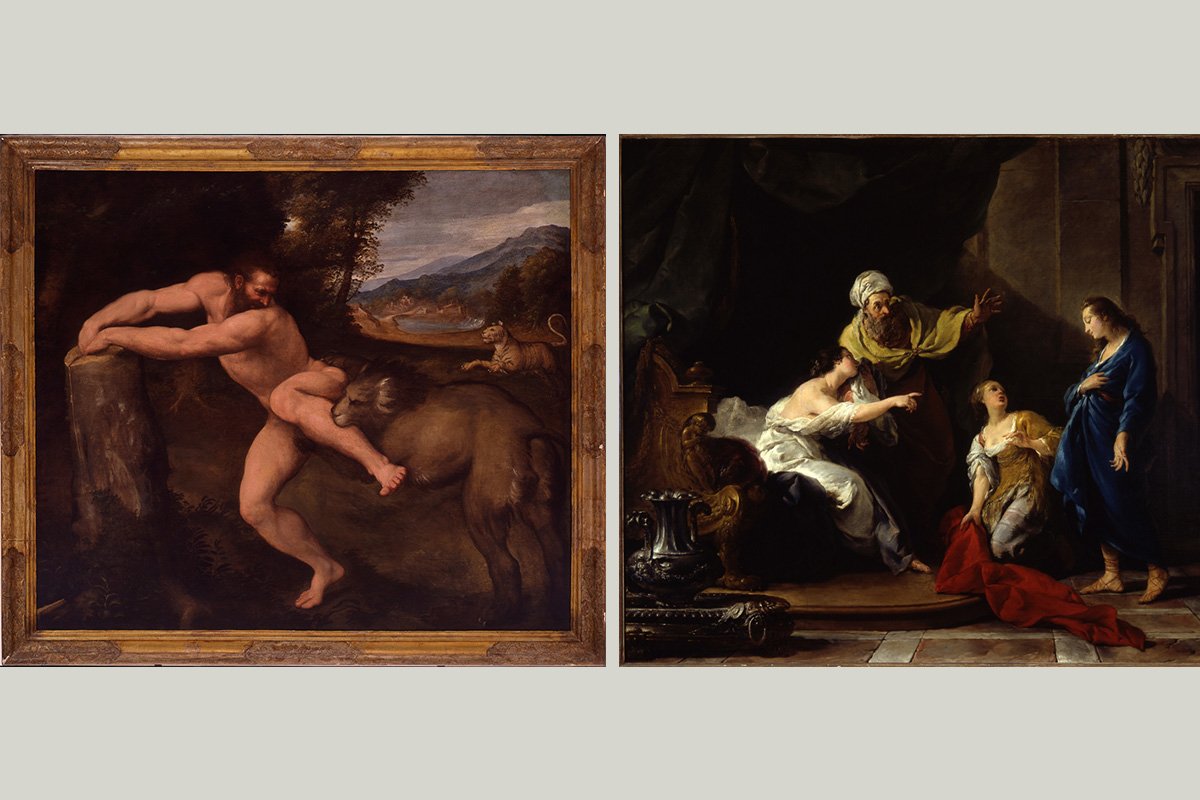
Smart Sightings | Caught Between Text and Image
The juxtaposition of paintings by Il Pordenone and Noël Hallé reflects the conceit of the exhibition: the value and dangers of comparison.
“Smart Sightings” is a new partnership between the Marty Center and the University of Chicago's Smart Museum of Art. This series invites readers to contemplate the many connections between art and religion through written reflections on pieces in the Smart’s exhibition, Calling on the Past: Selections from the Collection, on display at the museum from March 21, 2023 to February 4, 2024. Featuring illuminating pairings of objects from the museum’s permanent collection, Calling on the Past encouraged viewers to see the collection—and themselves—with fresh eyes.
Among the items on display in the Smart Museum’s new exhibition, Calling on the Past, is Milo of Croton Attacked by Wild Beasts (ca. 1534–1536) by the artist Giovanni Antonio de Sacchis, better known as Il Pordenone (1484–1539). The subject of the painting, the death of Milo, the famed athlete from the sixth century BCE, appears infrequently among the works of renaissance artists. Noël Hallé’s emotive portrayal of Joseph Accused by Potiphar’s Wife (ca. 1740–1744) hangs on the opposite wall. These two paintings, hailing from distinct periods and reflecting different literary traditions, appear to have little in common at first glance. Within the space of the gallery, I soon realized that the physical proximity of these paintings made unexpected parallels visible. As my eyes moved from one image to the other, I found myself drawn to a common thematic element central to both: men whose moral or physical strength is under threat.
Reminiscent of the classical hero Heracles and the biblical strongman Samson, Milo appears at the peak of his physical condition within Pordenone’s painting. Reputed to be a historical figure, Milo achieved fame for his physical strength and numerous victories within the Olympic Games. The bare body of Milo appears luminous against the background of shadowy landscape and fauna surrounding him. Upon closer examination, one notices Milo’s hands are held fast in the stump of a tree. One written source from the second century CE, Pausanias, relates that Milo had attempted to split a fallen tree in a display of his prodigious strength, but his hands became caught. Helpless, Milo fell prey to roving wild beasts. Within Pordenone’s visual interpretation, one creature sinks its teeth into Milo’s calf with its paws encircling his upper leg and groin. In the background, another feline-like creature appears ready to pounce. Without a mane and replete with rippled underbelly, the beast appears female in comparison with Milo’s immediate attacker. Holding his arms straight and twisting his legs, Milo turns his head to behold the beast with little emotion as the palpable violence of the scene unfolds.
In contrast to the bucolic setting of Milo’s demise, the confrontation of Potiphar with Joseph takes place within a lavish domestic space. As narrated in Genesis 39, the scene is the culmination of the repeated (but unsuccessful) attempts of Potiphar’s wife to seduce the youthful Joseph. Hallé depicts the unnamed woman encircling her husband’s arm with one hand and using her other to direct his gaze at Joseph. With shoulders bare and draped in fine white cloth, she leans toward her husband earnestly, simultaneously seductive and vulnerable. Meanwhile, a maid crouches, caught between the distraught couple and the accused with her eyes searching Joseph’s face. A red robe flows from her hand, presenting Potiphar (and the viewer) the purported proof of the allegation. The crimson garment unfolds across the scene, cutting Joseph off from the other characters and recalls the blood-stained garment his siblings once showed his father. Joseph serenely considers the cloth at his feet, clutching his blue robe as if preserving his modesty. Potiphar’s arm and hand, clasped by his wife, points downward toward her lap as his other hand gestures to Joseph, linking the three figures in a sordid triangle of allegation, disbelief, and silent abnegation.
While the biblical scene lacks the feral violence of Pordenone’s classical tableau, the sense of impending danger heightens the drama of both paintings. The beast attacking Milo and Potiphar’s wife share a similar posture, but as one familiar with the biblical story would know, the wife of Potiphar attacks not with claws and strength but with her deceitful tongue.
Long before Hallé took up his brush, literary and visual artists have represented this scene from Genesis, often embellishing the biblical story to render Potiphar’s wife the paradigmatic “wicked woman.” The embodiment of unrestrained feminine lust, writers such as Romanos the Melodist (ca. 485-560 CE) employed various strategies of vilify her. Emphasizing her identity as an Egyptian, Romanos expands her speech beyond the words attributed to her within the biblical account. His version of Potiphar’s wife threatens Joseph with death if he does not yield to her advances, lording over him her authority and reminding him of his enslaved status. Romanos also employs vivid animal imagery, describing her as both a menacing viper (44.7) and a wily fox (44.19). The juxtaposition of this image with the painting of Milo creates playful parallels between male protagonists and their adversaries, especially the convergence of the feminine and the animal as the source of danger.
The dominant interpretation of these stories casts the bestial and feminine forces as adversaries, one-dimensional villains bedeviling male protagonists. An alternative reading of these images sets aside the binary logic of good and evil to appreciate how these accounts depict the testing of (seemingly) self-sufficient masculine strength to reveal its vulnerability. A false accusation or the claws of an animal exposes the deceit of sovereign power. The story of Milo of Croton, less familiar to contemporary audiences, dramatizes the conflict between the protagonist with the natural world. Shifting our gaze away from the central figure, we may better appreciate the once-living tree, reduced to a mere stump which binds the human hands that previously sought to destroy it. The attacking animals serve as a counterbalance, checking the over-weaning extension of one organism’s power to the detriment of all. Perhaps as viewers living amid unprecedented ecological change brought about by human activity, we may consider Milo’s death in a different light than previous generations who reimagined this story.
Viewed alongside one another, the depictions of Milo and Potiphar foster deeper reflection on the themes of power. Read by later interpreters through the lens of gendered social hierarchies, the biblical story of Potiphar’s wife has solidified stereotypes of the danger of “feminine wiles.” While the #MeToo movement has drawn attention to the forces that silence victims of gender-based violence, the biblical episode foregrounds anxieties about the veracity of female speech and the threat of accusation to a man’s reputation. Reflecting on the biblical account in conversation with visual and literary interpreters across the centuries, we can see more clearly how her story is enmeshed in the matrices of power imbalances and identity: class, gender, and peoplehood. The biblical author characterizes this woman through her marital relationship, so we know her chiefly as the wife of Potiphar rather than by her own name. Hallé’s visual depiction of her as diminutive and physically entangled with Potiphar underscores their marital bond and Potiphar’s personal anguish. Through her fateful words against Joseph, she expresses agency within the shadowy constraints of cultural norms.
Both paintings give viewers the opportunity to reflect on power and powerlessness, and they do so especially when we consider them in conversation with one another. The juxtaposition of these images reflects the conceit of the exhibition: the value and dangers of comparison. The curators of Calling on the Past have cut across traditional organizing categories of geographical origin, subject matter, and chronology to provoke viewers to discern connections within unexpected assemblages. In my own research, I have often reflected on the stakes of comparative study and the necessity of justifying my decisions about what to include. As Bruce Lincoln has observed, comparison is both fundamental to human thought as well a source of its error. For both the academic study of religion as well as historical inquiry, comparison can be a double-edged sword, at once illuminative and obscuring. As Lincoln reminds us, “Comparison is never innocent, but is always interested.”
Featured Images: Pordenone, Milo of Croton Attacked by Wild Beasts, 1534 – 1536, Oil on canvas. Smart Museum of Art, The University of Chicago, The Cochrane-Woods Collection, 1975.31 (left). Noël Hallé, Joseph Accused by Potiphar's Wife, circa 1740 – 1744, Oil on canvas. Smart Museum ofArt, The University of Chicago, Gift of the Mark Morton Memorial Fund, and Mr. and Mrs. Eugene Davidson, 1974.116 (right).


